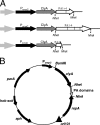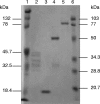Oral administration of a Salmonella enterica-based vaccine expressing Bacillus anthracis protective antigen confers protection against aerosolized B. anthracis
- PMID: 17145938
- PMCID: PMC1865694
- DOI: 10.1128/IAI.01242-06
Oral administration of a Salmonella enterica-based vaccine expressing Bacillus anthracis protective antigen confers protection against aerosolized B. anthracis
Abstract
Bacillus anthracis is the causative agent of anthrax, a disease that affects wildlife, livestock, and humans. Protection against anthrax is primarily afforded by immunity to the B. anthracis protective antigen (PA), particularly PA domains 4 and 1. To further the development of an orally delivered human vaccine for mass vaccination against anthrax, we produced Salmonella enterica serovar Typhimurium expressing full-length PA, PA domains 1 and 4, or PA domain 4 using codon-optimized PA DNA fused to the S. enterica serovar Typhi ClyA and under the control of the ompC promoter. Oral immunization of A/J mice with Salmonella expressing full-length PA protected five of six mice against a challenge with 10(5) CFU of aerosolized B. anthracis STI spores, whereas Salmonella expressing PA domains 1 and 4 provided only 25% protection (two of eight mice), and Salmonella expressing PA domain 4 or a Salmonella-only control afforded no measurable protection. However, a purified recombinant fusion protein of domains 1 and 4 provided 100% protection, and purified recombinant 4 provided protection in three of eight immunized mice. Thus, we demonstrate for the first time the efficacy of an oral S. enterica-based vaccine against aerosolized B. anthracis spores.
Figures




Similar articles
-
Anthrax protective antigen delivered by Salmonella enterica serovar Typhi Ty21a protects mice from a lethal anthrax spore challenge.Infect Immun. 2009 Apr;77(4):1475-82. doi: 10.1128/IAI.00828-08. Epub 2009 Jan 29. Infect Immun. 2009. PMID: 19179420 Free PMC article.
-
Salmonella enterica serovar typhimurium expressing a chromosomally integrated copy of the Bacillus anthracis protective antigen gene protects mice against an anthrax spore challenge.Infect Immun. 2003 Jul;71(7):3831-6. doi: 10.1128/IAI.71.7.3831-3836.2003. Infect Immun. 2003. PMID: 12819066 Free PMC article.
-
Towards a human oral vaccine for anthrax: the utility of a Salmonella Typhi Ty21a-based prime-boost immunization strategy.Vaccine. 2008 Nov 11;26(48):6083-91. doi: 10.1016/j.vaccine.2008.09.010. Epub 2008 Sep 19. Vaccine. 2008. PMID: 18805452 Free PMC article.
-
Progress and novel strategies in vaccine development and treatment of anthrax.Immunol Rev. 2011 Jan;239(1):221-36. doi: 10.1111/j.1600-065X.2010.00969.x. Immunol Rev. 2011. PMID: 21198675 Review.
-
Vaccines against anthrax based on recombinant protective antigen: problems and solutions.Expert Rev Vaccines. 2019 Aug;18(8):813-828. doi: 10.1080/14760584.2019.1643242. Epub 2019 Aug 6. Expert Rev Vaccines. 2019. PMID: 31298973 Review.
Cited by
-
Osteopathic lymphatic pump techniques to enhance immunity and treat pneumonia.Int J Osteopath Med. 2012 Mar;15(1):13-21. doi: 10.1016/j.ijosm.2011.11.004. Int J Osteopath Med. 2012. PMID: 22977459 Free PMC article.
-
Lymphatic pump treatment augments lymphatic flux of lymphocytes in rats.Lymphat Res Biol. 2010 Dec;8(4):183-7. doi: 10.1089/lrb.2010.0009. Lymphat Res Biol. 2010. PMID: 21190489 Free PMC article.
-
Protection against inhalation anthrax by immunization with Salmonella enterica serovar Typhi Ty21a stably producing protective antigen of Bacillus anthracis.NPJ Vaccines. 2017 Jun 15;2:17. doi: 10.1038/s41541-017-0018-4. eCollection 2017. NPJ Vaccines. 2017. PMID: 29263873 Free PMC article.
-
BECC-engineered live-attenuated Shigella vaccine candidates display reduced endotoxicity with robust immunogenicity in mice.Res Sq [Preprint]. 2024 Jun 11:rs.3.rs-4448907. doi: 10.21203/rs.3.rs-4448907/v1. Res Sq. 2024. Update in: Vaccine. 2025 Mar 19;50:126779. doi: 10.1016/j.vaccine.2025.126779. PMID: 38946947 Free PMC article. Updated. Preprint.
-
Anthrax protective antigen delivered by Salmonella enterica serovar Typhi Ty21a protects mice from a lethal anthrax spore challenge.Infect Immun. 2009 Apr;77(4):1475-82. doi: 10.1128/IAI.00828-08. Epub 2009 Jan 29. Infect Immun. 2009. PMID: 19179420 Free PMC article.
References
-
- Baillie, L. 2001. The development of new vaccines against Bacillus anthracis. J. Appl. Microbiol. 91:609-613. - PubMed
-
- Chatfield, S. N., K. Strahan, D. Pickard, I. G. Charles, C. E. Hormaeche, and G. Dougan. 1992. Evaluation of Salmonella typhimurium strains harbouring defined mutations in htrA and aroA in the murine salmonellosis model. Microb. Pathog. 12:145-151. - PubMed
-
- Coulson, N. M., M. Fulop, and R. W. Titball. 1994. Bacillus anthracis protective antigen, expressed in Salmonella typhimurium SL3261, affords protection against anthrax spore challenge. Vaccine 12:1395-1401. - PubMed
-
- Duc, L. H., H. A. Hong, H. S. Atkins, H. C. Flick-Smith, Z. Durrani, S. Rijpkema, R. W. Titball, and S. M. Cutting. 2007. Immunization against anthrax using Bacillus subtilis spores expressing the anthrax protective antigen. Vaccine 25:346-355. - PubMed
Publication types
MeSH terms
Substances
Grants and funding
LinkOut - more resources
Full Text Sources
Other Literature Sources
Medical

